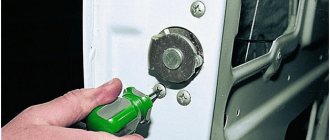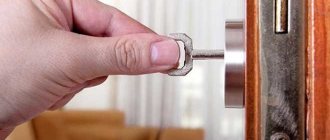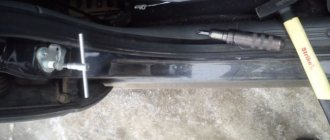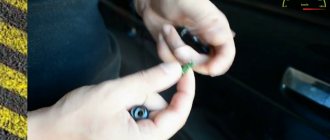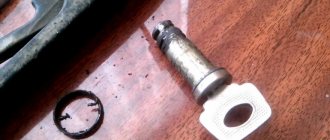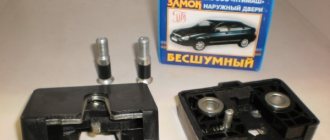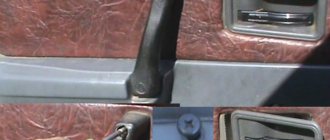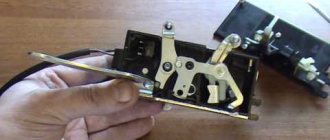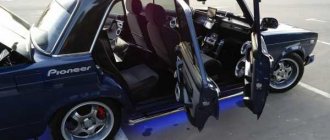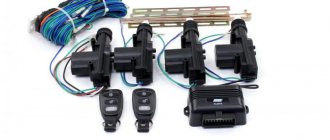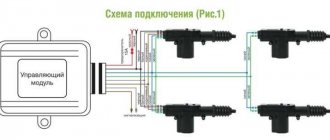Thanks to its low price and ease of maintenance, the VAZ “Seven” is still one of the most popular models among Russian car owners. The factory equipment of the car, to put it mildly, is not oversaturated with options. Therefore, connoisseurs of convenience and comfort modify it by installing additional elements. The central locking of the VAZ 2107 makes using the car easier and more enjoyable, allowing you to open and close the doors using the alarm key fob. You can install central locking (CL) yourself. For this, basic plumbing skills and school knowledge of electrical engineering are sufficient.
What is required to install a central lock on a door?
- A working and installed car alarm system with power outputs for controlling door locks.
- Activators, actuators, actuators, solenoids, electric drives or, finally, just central locks - 2 pcs.
- The wires are two-core, copper. The diameter or cross-section of each wire must be at least 0.75 square. Length about 3-4 meters.
- Plastic clamps – 10 pieces, maybe more, “in reserve”.
- Other: electrical tape, heat shrink tubing, wire cutters, screwdriver, soldering iron, solder, multimeter, drill, drill bits, electrical extension cord, etc.
Before we begin directly installing central locks, we will analyze each point above in order, in more detail.
1) In this article we will not talk about how to install an alarm yourself, but we will assume that it is already installed. The cheapest option (about 1300 rubles) is a simple alarm without feedback.
Which model to choose, how to connect correctly, how much it costs and other questions about car alarms will be discussed in another article. Just a few important points to keep in mind.
Firstly, the main alarm unit must have a connector (usually 6-pin) with power outputs for connecting door locks. Secondly, before purchasing, decide in advance whether you need an additional alarm channel. It can be used to open the trunk or, for example, implement the “light path” function and other similar functions. It all depends on your imagination and ideas, so it’s up to you. 2)
Lock activators are not called by any name, so don’t be surprised by so many names. We will stick to this term. The central locking solenoid most likely refers to an electromagnet, which is most often installed to open the trunk. In terms of power (traction force) it is much stronger than plastic activators, but it is also more expensive.
The approximate price for a regular central locking activator with 2 outputs (two-wire electric lock) is 100-120 rubles. a piece. For 2 doors you will need two activators, the total cost is about 250 rubles. The kit for each activator includes a special strip for attaching the central lock and self-tapping screws, as well as a rod, screws and a metal retaining plate.
3) To save insulating tape, copper wires in general insulation around the insulated conductors, but you can also buy them separately (single-core). The cross-section of the conductor must be at least 0.75 square. The current consumption of a conventional electric central locking drive can reach 5A at its peak.
In auto stores you can choose wires of various diameters, colors and lengths. Some are sold in ready-made installation kits or kits. Individually or “by meter,” most often, single (single) wires are found.
We recommend going to a regular electrical supply store and purchasing a two-conductor copper cable (the individual wire of which has a stranded conductor). For example, a PVS 2×0.75 cable (with a polyvinyl chloride sheath) or a PVS 2×1 mm cable is suitable. These wires are used to connect various electrical appliances, power tools and other machines and devices. The cost is about 12-15 rubles per 1 meter.
You can look for special automotive PGVA wires, which are intended for automotive equipment and instruments. They also have polyvinyl chloride insulation and are undoubtedly suitable for connecting central locks.
For reference: PGVA wires are designed for flexible connection of electrical equipment and devices with a low rated voltage (up to 48 V) in temperate, tropical and cold climates. PGVA wire is resistant to vibration loads, cracking, gasoline and oils. When laid alone, it does not spread fire.
When installing additional devices and using a second alarm channel, carefully study the table with permissible current loads. Most likely, to install a powerful solenoid that will open the trunk lock, an additional unloading relay will be required.
4)
Plastic tape clamps will be needed to secure the wires. Purchase at will, 10 pieces will be enough.
A set of 100 pieces measuring 2.5×100 costs about 50 rubles.
5) Other tools, devices and materials that may be needed during installation.
Methods for connecting the central lock
Installing a central lock on a VAZ 2107 can be done in two versions:
- together with alarm system (without central locking control unit);
- with central locking control unit.
In the first case, you will have to install an alarm with a unit that supports the function of direct control of the lock drives. This will save on the purchase and installation of a separate central locking unit. In the second case, you will have to spend money on a control unit, but the central locking can be coordinated with any type of alarm or even used without it (for example, to lock and unlock all doors by turning the key in the driver's door lock).
Installation of motors
In order to install the motors we need, we will have to drill holes in each door. We recommend that you install VAZ 2107 locks, starting with the rear doors.
To get started, remove all unnecessary elements: plastic lining and casing. Take a drill and make a hole in the door. Through it we will subsequently pull the wiring from the stand to the door. Drill a second hole in the rack. Now let's start drawing the wires. Don't forget to use corrugation.
Read, it may come in handy: Mud flaps on the VAZ 2107: replacement features
Rear door wiring
Now you can install the engine. When installing, do not forget to check that it does not interfere with the operation of the glass. It's a small matter. We fasten the motor rod and the lock lock rod to each other using a bar. It should be included with the central locking system. Now, actually, it's ready. Let's move on to the front doors.
Installing motors on the front doors will not take much time. In this case, we place them in the left and, accordingly, the lower right corners of the doors. We install according to the example of the rear doors and perform a test.
Installing engines on the front doors
How to connect the central locking to the alarm system?
Since the VAZ 2101-2107 car is not initially equipped with a central locking or electric door lock drives, you can install additional electric drives and connect them to the system as follows.
Central locking connection diagram
The blue-white and orange wires of the 6-pin connector of the main unit of the alarm system are connected through 15A fuses to +12 V DC. Green and blue wires to the vehicle ground or, in other words, “ground”.
The white wire is to the blue door lock activator unlock wire, and the yellow wire is to the green power lock wire.
Most Chinese car alarms, especially inexpensive models (APS 2600 SHERIFF, Pantera CLK 355), have blocks similar in structure. Sometimes it seems that Chinese manufacturers only change the label, but the “filling” remains the same. At least, the 6-pin connector itself with power outputs for locks, as well as the colors of the wires, differ quite rarely.
Having familiarized yourself with the central locking connection diagram, feel free to start connecting the wires and checking the operation of the activators. After successful tests, all that remains is to assemble all the removed parts in place and then carry out a “control” check.
Job done, congratulations! The approximate cost is about 500 rubles, excluding the cost of signaling.
Central locking diagram for VAZ 2107
The actuator wires are routed inside the doors and lead to the control unit. The wires must be routed out of the doors through a protective corrugated tube. The power supply of the control unit must be connected to the positive wire of the battery. You can connect the “plus” from the ignition switch or fuse block, for example, from the terminal of the fuse that powers the clock. When connecting the unit to the ignition switch, it is necessary to install an additional 10A fuse to protect the circuit from overloads.
Step-by-step instruction
Defense System Kit
Due to the extra time spent, car owners often refuse to install activators in the rear doors of their vehicle. However, this procedure is not complicated. Initially, you will need to remove the retaining spring. You can do this in 2 ways:
- removing the lock,
- using a thin, slightly bent screwdriver without removing the lock.
Otherwise, due to the tight movement of the rod, the activator will not be able to cope with the load placed on it. The electrical wire must be installed in the area of the mechanical lock. To do this, you will need to make a hole to fix the back of this installation and 2 holes for the plate. The electric drive can be positioned in the opposite direction. In this case, installing an alarm system on a VAZ 2107 with your own hands involves the use of 2 plates.
The activator rod is fixed to the rod using bolts. As for laying the wire itself, this will require making a hole in the rear doors, the diameter of which will coincide with that of the rubber bushing. This should be done 95-100 mm lower than the lower part of the upper hinge of the rear door. You will also need to make a coaxial hole in it.
Next, install the wires under the hood. They need to be laid through a seal. To do this, a hole is made in the place where the headlight hydraulic corrector tube passes. The siren and limit switch are mounted on a slightly bent mounting plate.
The luggage compartment limit switch provides for sawing off the mounting plate and the electric drive for opening the trunk itself. When attaching the limit switch, it is not recommended to completely unscrew the nut. Otherwise, it will be difficult to lock the spring back. To install it, a slot is made in the trunk lock. The electric drive should be secured to the trunk lid. A flexible cable can be used as a connecting element.
Localization of central locking faults
All malfunctions of the central locking system (CL) can be divided into the following categories: complete or partial failure; The lock does not work or malfunctions due to mechanical or electrical defects or damage. When identifying malfunctions of the central locking system, you should rely on this classification and begin repairs not with any specific actions, but with diagnosing the equipment. This will save a lot of time, and possibly finances.
The central locking must function regardless of whether the car engine is running or not, and whether the ignition is on or not - the main thing is that the on-board network is not de-energized (the power terminals must be connected to the battery). The entire system consists of connecting wires, switches and:
- electric drives (solenoids or mechanisms with a motor) – electric central locking;
- vacuum drives, tubes, compressor and its control board - pneumatic (vacuum) central locking.
Actuators are usually called actuators or activators. A control drive is installed in the driver's door of the car, and also often in the front passenger door, which, when activated, sends an electrical signal through separate wires to open/close the remaining doors (to the control board or to the power relays of the remaining doors - only in the electric central locking system).
If you have a car alarm, repairs begin with testing it. If the central locking does not work from its portable remote control, then first of all you should check how it works from the key and the button for opening/closing the driver's door (and the front passenger door, if it also has a control drive). When the central locking is operated “manually”, you should look for a fault in the electrical and control alarm circuits. First of all, you need to check the battery of the remote control - it may be low.
FakeHeader
Comments 17
Heavy hehehehe. The corrugation is not for this car, you need to install rubber tubes that are specially designed for classics.
The actuator connector had to be cut off, twisted, ideally, soldered again... And the rods had to be wrapped with foam rubber so as not to rattle)...
PS: So I understand, the car is not yours, let the owner deal with this... For a couple of seconds. could have been done, of course, for an additional fee. fee).
The power of the actuators is not enough because the bimetal wiring is laid with a real cross-section of less than 0.7. This is called hack work. These wires are not even tinned. It's been like a year. I have already replaced the wiring for myself and my friends to 1.5 kV. The actuators fire even on a dead battery. Previously there were constant problems. Including periodic failures of actuators in different doors
I will not argue. Perhaps the wiring is bad, but this problem occurs even in cars with factory central locking (VAZ 2110 and modifications). And all problems were solved by removing the springs.
The exact definition of this action is “crutches”. By the way, I don’t have them either, since at one time I solved the problem along the path of least resistance. In the end, I had to do it for myself once and for all
It is better to install corrugations straight. These S-ki quickly dry out and crack, and they are compressed when the door is closed. Now just a classic in the works. True, I had to install two rubber bands, there are a lot of wires (activator, ESP, heated mirrors, speaker).
Basically, all rubber bands dry out and crack.
Corrugations are faster because they work in torsion all the time
It is better to install corrugations straight. These S-ki quickly dry out and crack, and they are compressed when the door is closed. Now just a classic in the works. True, I had to install two rubber bands, there are a lot of wires (activator, ESP, heated mirrors, speaker).
What exactly are these rubber bands called?
Strange ! Alarm? Are they being stolen? According to my Classic Wazen Tazen from Kopeyka to Semerka, Alarms and locks are no longer needed at all!
Well, I don’t know... for me, locks are a convenience, a way to automatically heat up and find out the temperature outside, and protection from dirty tricks.))
So the Center-Lock is separate, and the Alarm is also separate. You can install just a Center-Lock without an Alarm. I asked why the Old Lady had an alarm system.
Well, I wrote - the locks are there for convenience - so that in the cabin you don’t have to poke the flag on each door - but just press the button and all the doors are closed.))
Causes of malfunctions
If the central locking stops working, you must first check the fuse box. Short circuits and various disturbances often occur in the central locking system, which leads to blown fuses.
Checking system fuses
The central lock does not operate when the battery is completely discharged. To check, you need to open the central locking with the key and try to start the car. If it does not start, then the reason is the battery is discharged.
The reason why the central locking system does not work may be due to a breakdown of the electronics. You can open the car without a key using the key fob. If the central locking does not open with the key fob, you should check the batteries and buttons of the key fob. They may stick and not work at the right time.
At the next stage, using the instructions, you should check the alarm control unit. It is possible that due to problems with it, the central locking works, but does not close all the doors. The last thing to check is the microboard, which is located on the activator motor, and at the same time the drive itself should be checked. Defective parts must be replaced.
Electrical circuit diagram for central locking
If the central locking does not work, this may be due to mechanical problems: the cylinder drive hose is faulty. The signal received by the control unit from the key fob is transmitted to the motor on the doors, which should operate and act on the hose fixed in the cylinder. If one end of the hose falls out of the cylinder, the drive is turned off. In this case, the door will not be able to open or close. Thus, the reasons why the lock does not work or malfunctions can be either electrical or mechanical.
Read it, it might come in handy: Do-it-yourself beard: step-by-step instructions (photos and videos)
